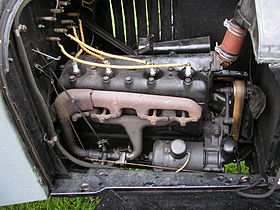Ford Model T engine
| Ford Model T engine | |
|---|---|
 |
|
| Overview | |
| Manufacturer | Ford Motor Company |
| Production | 1908–1941 |
| Combustion chamber | |
| Displacement | 177 cu in (2.90 L) |
| Cylinder bore | 3 3⁄4 inches (95.25 mm) |
| Piston stroke | 4 inches (101.6 mm) |
| Cylinder block alloy | cast iron, monobloc design |
| Cylinder head alloy | cast iron, detachable |
| Valvetrain | side valve (flathead) |
| Combustion | |
| Fuel system | gravity feed, carburetted |
| Fuel type | flex-fuel, primarily gasoline |
| Cooling system | water, thermosyphon |
| Output | |
| Power output | 20 hp (15 kW) |
The Ford Model T used a 177 cu in (2.90 L) inline 4-cylinder engine. It was primarily a petrol engine, but it had flex-fuel ability (called multifuel at the time) and could also burn kerosene or alcohol. It produced 20 hp (15 kW) for a top speed of 45 mph (72 km/h). It was built in-unit with the Model T's novel transmission (a planetary design), sharing the same lubricating oil.
The T engine was known for its simplicity, reliability, and economy. The engine remained in production for many years, and millions of units were produced. The engine design's lifespan exceeded that of the Model T vehicle itself, with industrial, marine, and military applications extending its production run. The T engine is on the Ward's 10 Best Engines of the 20th Century list.
The T engine was primarily a petrol engine, but it had multifuel ability and could also burn kerosene or ethanol. According to Ford Motor Company, the Model T had fuel economy on the order of 13–21 mpg‑US (16–25 mpg‑imp; 18–11 L/100 km).
The T engine had one carburetor, a side-draft, single-venturi unit. Its choke and throttle valves were controlled manually; the latter was with a hand lever rather than a foot pedal. The carburetor had no accelerator pump. Various vendors supplied Ford with carburetors for the T engine, including Holley, Zenith, and Kingston.
...
Wikipedia
